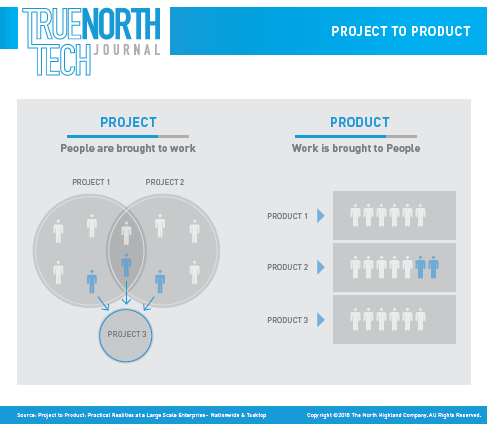
Highly effective teams are so much more than a collection of interchangeable resources. They are stable, integrated units designed to build, enhance, and support a technology solution across its entire lifecycle. Through the intentional creation of defined and stable membership, everyone knows whom they should be collaborating with and the skill sets they need to develop. This enables everyone to quickly get into – and remain in – what NYU Stern professor Bruce Tuckman calls the “performing” stage, the end state of a “forming, storming, norming” process.
However, traditional people management and development practices don’t optimize teams for long-term stability and integration towards the development of technology solutions. In large part, it’s because traditional people management practices don’t account for the true value of stable, integrated teams. Borrowing from behavioral science author Daniel H. Pink’s book “Drive,” which applies data to demonstrate what really motivates teams and individuals, those values can be articulated through the lenses of autonomy, mastery, and purpose.
Autonomy: Stable, integrated teams are driven to self-organize. The control previously provided by more rigid processes is replaced by clarity around product roadmap and ownership. This autonomy drives efficiencies as members are freed to focus on – and fully own – their team outcomes rather than being split across multiple workstreams of scope and resulting dependencies (programs/projects). Moreover, teams can organize their own ways of working and introduce other collaborative behaviors that truly fit the team’s personalities. These practices generate value faster through accelerated responsiveness to customer needs. In bringing this principle to life, we recently worked with a client to ensure that when scheduling a minimum viable product (MVP) deployment there was change management expertise on the team – rather than waiting for the approval of a governance board for the initial release of new product features.
Mastery: The stability of a long-term team enables members to develop high levels of expertise coupled with a collaborative ethos. As a result, the team will naturally swarm around work that drives knowledge sharing and grows T-shaped skill sets (those that have deep knowledge or skills in a particular area of specialization but can be readily connected across disciplines). To activate mastery with our clients, we often pair disparate members of cross-functional teams – such as a UX designer and an engineer—to nurture T-shaped skillsets. This approach enables speed to customer value because it equips the engineer to support with UX design when there is a high need for that skill during product development.
Purpose: Working together over the course of a project, individuals naturally normalize by forming working relationships and a sense of identity as a team. When combined with a strong organizational vision, this provides individuals with a collective sense of purpose and clarity. In our work with clients, we focus on establishing up-front alignment around organizational vision and mission, in turn ensuring that team members know why they’re coming to work and the common goal they’d like to achieve.
Designing and empowering a stable, integrated team brings a unique set of challenges. In a project world we form temporary teams around demand and in a platform or product world we take demand to the teams (see diagram below). As organizations attempt to transition to a product and/or platform structure, it’s often found that existing work doesn’t always easily flow into structures you are trying to create (this can be particularly arduous when there are large programs in-flight). Moreover, unless you are integrating the entire organization, a single stable, integrated team will always butt up against the barriers of status quo.

In our experience in helping to design and empower stable, integrated teams, we’ve encountered some common challenges and client fears. In many cases, there are simple workarounds to achieving a team structure that can efficiently and proficiently manage the entire lifecycle of a solution:
Stability is associated with hindered career development. First, stable does not mean static. There has to be some movement, by design, based on career development. Utilizing resource management software can further enhance this movement by ensuring that resources are allocated efficiently based on team members' skills and project requirements. Second, a stable, integrated team encourages T-shaped individuals who are constantly increasing their skill sets and mentoring others to do the same.
Stable teams make demand management more complex. Because individuals can’t be juggled between teams to increase or shrink bandwidth, organizations must approach demand management using backlogs by product group (or product family) and conduct resource planning at the team level. This approach enables a greater focus on prioritization.
Team design is difficult . . . and permanent. Where do you put an individual who has a skill set that would align them to more than one product or platform? Employ a mantra of “job security, role evolution” to the team design to reinforce the idea that roles and skill sets constantly evolve and team structures will need to adjust to accommodate.
Involving third parties that don’t work the same way we do would be nearly impossible. In a true partnership, both organizations must be open to adaptation. In fact, we have been part of a collaborative team for the last 12 months that achieved exactly this. North Highland has been working with a UK retailer to design, experiment on, create and MVP, roll out, and continuously improve a new operating framework for their digital and technology function. Instead of a traditional consulting approach, we’ve closely integrated with the client team on the framework.
It is hard to decide which roles, if any, should be considered specialist. Specialists often take roles in more than one team, usually due to lack of a full-time commitment needed to one team. But specialists should have one primary team, and aspire and work toward being a member of only one team.
What happens to the line managers? The role of line management will evolve. Line managers will still exist but they will be focused on reducing organizational-level impediments and supporting teams by evolving their skill sets and taking ownership of their products.
It’s risky to be part of a team that owns a product that is only guaranteed funding for a defined period of time. It’s natural for team members in this scenario to be worried that their jobs are at risk. The solution is to fund teams and subsequently agree on what work (which product(s)) the team should focus on with finance and customers. It comes back to the mantra of “job security, role evolution” again, but in this case the role evolution applies to exactly which product the team will be working on.
Start small with a stable, integrated team than is empowered to own a solution from design through deployment. Monitor and assess what works, what doesn’t, and promote each success to scale over the long-term and across the organization.
